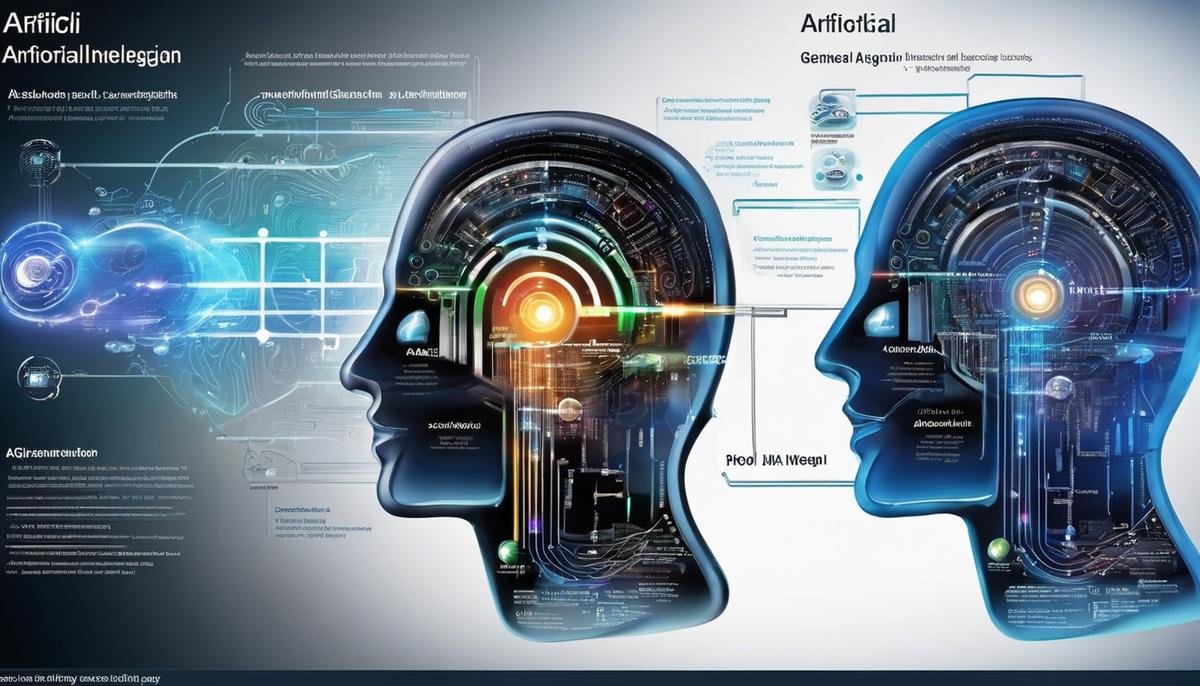In the ever-evolving landscape of technological innovation, two key terms have steadily gained prominence – Artificial Narrow Intelligence (ANI) and Artificial General Intelligence (AGI). These concepts, born out of the realm of artificial intelligence, represent disparate facets in the quest for machine learning and autonomous reasoning. Interestingly, despite being drawn from the same parent discipline, they diverge significantly in their applications, challenges, and potential trajectories. ANI or weak AI, as it is commonly referred to, specializes in single, narrowly defined tasks, a stark contrast to the expansive reach and capabilities of AGI – the hypothesized potent form of AI that mimics human intelligence in its entirety. Nevertheless, both are critical in shaping our technological advancements and the future of myriad sectors.
Defining Artificial Narrow Intelligence (ANI) and Artificial General Intelligence (AGI)
Understanding ANI and AGI: A Comprehensive Detailing of Conceptual Distinctions
Artificial Intelligence (AI) represents a critical frontier in scientific exploration and innovation. However, it is not a singular, homogenous entity. Rather, it unfurls into a spectrum of classifications. Two significant divisions within this classification scheme, seemingly related but inherently distinct, are Artificial Narrow Intelligence (ANI) and Artificial General Intelligence (AGI). Grasping these differences sets the basis for a nuanced comprehension of contemporary AI studies.
Artificial Narrow Intelligence, commonly referred to as ‘Weak AI’, embodies the current instantiation of Artificial Intelligence technology. It is purpose-specific, designed and trained for servicing a restricted array of tasks. A quintessential example of ANI is a chess-playing program; it exhibits superb capabilities in the realm of chess, outperforming even the most seasoned human players. However, beyond this limited ambit, its intelligence remains largely ineffectual, unable to carry out or comprehend activities outside of its preprogrammed parameters.
ANI is the most pervasive form of AI presently, permeating multiple facets of everyday life, from Google’s search algorithms to voice-controlled virtual assistants like Siri and Amazon’s Alexa. It excels within its defined remit, wholly reliant on the data provided and the job it has been trained to accomplish. It neither comprehends nor learns beyond the operational circumstances it has been devised for.
On the other end of the spectrum rests Artificial General Intelligence—significant in its potential, though presently unsubstantiated. AGI, often termed ‘Strong AI’, represents the conceptual zenith of AI, embodying a machine’s capacity to understand, learn, and apply knowledge across a broad range of tasks, just as a human would. The definitive trait of AGI is its ability to independently undertake any intellectual task that a human being can.
In essence, AGI would not merely follow programmed instructions but possess a deep, intrinsic understanding, making decisions based on reason and learning from experiences. It is this aspect of AGI—the capacity for comprehensive learning and cognitive functioning—that starkly differentiates it from its ANI counterpart. However, it’s key to note that despite accelerated advancements in AI, AGI remains predominantly within the realm of hypothesis and projections.
The prime distinction between ANI and AGI lies in their scope of functionality and learning capacity. ANI excels in narrow, predefined tasks, demonstrating superior performance but lacking the capacity for generalized understanding or learning beyond its programming. Conversely, AGI envisions a breadth of application and cognition: a machine intelligence rivalling human cognitive abilities across diverse tasks, capable of reasoning, problem-solving, and conceptual understanding—a self-directed quest of knowledge.
These delineations elucidate the multi-faceted nature of AI and the conceptual spread within it—from the existing and acutely proficient ANI to the aspirational and apparently prepotent AGI. The acknowledgement of these categories is not just of scholarly interest, but it holds profound implications for comprehending the developmental trajectory, potentialities, and the inevitable implications that AI has in store for society.

Application and Scope
Without further ado, let’s delve deeper into the fascinating realm of artificial intelligence, focusing on the applications and functional capabilities of Artificial Superintelligence (ASI) and Artificial General Intelligence (AGI).
Artificial Superintelligence (ASI) is an eventual architectural evolution of AGI, capable of surpassing human comprehension in nearly every conceivable discipline, including scientific creativity, general wisdom, and social finesse. It possesses intelligence that is immeasurably beyond the boundary of brightest and most gifted human minds. ASI, not yet realized, is indeed a future projection.
Counterpart to this and already defined, we have Artificial General Intelligence (AGI), which equals the cognitive performance of a human being in most economically valuable work. AGI can be trained to comprehend and learn any intellectual task that a human being can, while also maintaining the capacity for autonomous learning and optimizing its own programs.
One significant distinction between AGI and ASI lies in the realm of adaptability and the ability to learn autonomously. AGI can learn and understand any intellectual task that a human can, but requires frequent input and guidance from human operators. In stark contrast, ASI is designed to learn and adapt autonomously, redefining its learning strategies and even reprogramming itself if needed.
This distinction lays the groundwork for their different applications. AGI, with its human-like intelligence, is perfect for tasks that require human-like understanding and responses. These include advanced research, complex decision-making in business environments, and potentially sensitive operations in healthcare where human-like reasoning is vital. AGI, by virtue of its capabilities, offers a solution to many businesses and industries where human expertise, decision making, and problem-solving are required.
On the other hand, ASI goes far beyond these capacities. Not only can ASI comprehend, learn, and adapt to tasks autonomously, but it can also potentially outperform human brilliance in every field imaginable. This includes advanced scientific research, macroeconomic modeling, global climate prediction, and other intellectual domains human minds may struggle. Its scope of operation isn’t just limited to solving immensely complex problems, but also in creative domains like arts and literature.
However, it’s crucial to remember that these future capabilities introduce potential challenges as well. The development of AGI and ASI must be approached judiciously to ensure that it aligns with aligned human values and can be controlled so as not to pose a risk to humanity.
In conclusion, ASI’s potential to surpass human intelligence in every capacity makes it a captivating concept. However, the continuous pursuit of AGI is equally as critical, offering immense future benefits. The exploration of these AI forms augurs a compelling chapter of human scientific endeavor, and rightfully so, as AI continues its march onwards, expanding the realm of possibilities in the process.

Technical Challenges and Limitations
The journey towards the realization of Artificial Superintelligence (ASI) and Artificial General Intelligence (AGI), as compelling as these concepts are, is fraught with substantial technical hurdles and limitations. It’s akin to standing at the base of an immense mountain, keenly aware of both, the summit’s allure and the dangers that lie en route.
Technical challenges present in developing AGI are substantial. An AI system with ‘general intelligence’ is expected to comprehend a broad spectrum of tasks substantially better than humans can. For such an AI, the ability to learn ‘on the go’ and optimize its responses in novel circumstances is crucial. But teaching computers the complexity of our world is no easy feat. Building data models that provide evolving contextual understanding remains problematic. Additionally, there’s the question of computational capacity, timing, and architecture. The neural networks behind AGI require vast computational capabilities as well as unique architectural arrangements to mimic the human brain’s astonishing complexity and flexibility.
This complexity reinforces the need for seamless data integration across different fields. Such integration is currently limited by the presence of multiple data repositories with incompatible formats and structures. Overcoming these issues demands advancements in robust algorithms for data cleaning, merging, analysis, and interpretation. Furthermore, the pathway to AGI demands advancements in the complexity and sophistication of reinforcement learning systems, allowing systems to learn from their mistakes effectively.
The development of ASI, an intelligence that is significantly beyond the brightest human minds in practically every field, presents an even steeper set of challenges. Achieving ASI might mean creating an AI system that not only imitates human intelligence but drastically exceeds it. But we run into a paradox here. It is challenging to conceptualize, let alone construct, a system smarter than ourselves. The tools we have might not be adequate to build such a system, mirroring the trap of an artist attempting to paint a landscape beyond their perceptual reach.
One technical limitation to ASI development includes the problem of computational resource efficiency. It remains uncertain whether our current processing power and energy resources can support an ASI effectively. Additionally, there’s the issue of ‘recursive self-improvement’, a key characteristic of ASI. Although the idea of an AI system improving itself sounds ideal, it’s technically challenging to implement without leading to destabilizing feedback loops.
Moreover, making ASI safe and controllable is a monumental challenge. It involves not only the development of fail-safe mechanisms but also the incorporation of ethics and laws, without hindering AI’s learning and adaptability. This raises important questions about the regulation and standardization of AI systems and the accountability for their actions.
Conclusively, while the concept of AGI and ASI holds great promise, achieving them necessitates clearing substantial technical hurdles and overcoming complex limitations. These challenges underscore the sheer magnitude of the scientific feat we’re striving for, making it not only a journey into the future, but also a testament to our technical ingenuity and intellectual resolve. As we continue to chip away at these challenges, the summit seems distant, but each effort brings us a step closer to these grand visions of artificial intelligence, and ultimately, a better understanding of our own intelligence.

Future prospects
As we gaze over the landscape of artificial intelligence, an epochal shift emerges from the terrain that is Artificial Superintelligence (ASI), promising a world of vast potential and complexity. Indeed, ASI, a level of intelligence which surpasses all human intelligence, could be the harbinger of a future that reshapes societal structures and expectations.
However, traversing this complex landscape requires navigating a series of challenges. These range from computational resource efficiency to recursive self-improvement. As we venture into the realm of ASI, computational resources become more than simply a concern about efficiency – this becomes a question of the sustainability of our advancements. This concern is further complicated by the issue of recursive self-improvement. Envision a scenario where an artificial system becomes capable of improving itself independent of human intervention. This potential autonomy raises substantial questions concerning control, safety, and implications of unexpected behavior.
One cannot advocate the relentless pursuit of advanced AI without an equally vigorous commitment to safety measures. The power of ASI also poses new paradigms on safety and controllability. As research pushes the limits of AI, strategies need to evolve to ensure these superintelligent systems remain not only controllable but also beneficial. The inherent complexity of ASI makes this an ongoing task that cannot be underestimated or overlooked.
Meanwhile, amidst this rapid technological evolution, introducing ethics into AI systems becomes a salient conversation. Our AI solutions must be not only intelligent but also trustworthy. AI systems must prioritize respect for human rights, interpretability, justice, and avoid discrimination. Advocating for the integration of such values into the development stage of AI technologies is a moral imperative.
In concert with ethical concerns, the issue of regulatory frameworks and standardizing AI systems prevails as a topic of considerable interest. Our society, still grappling with concepts of ANI and AGI, now stands on the threshold of translating these concepts into law and societal norms. The challenge lies in framing laws that accommodate advancements in AI, managing their impacts without stifling the innovation that can benefit humanity.
Lastly, though AI systems may be increasingly independent, it does not absolve us, as a society, from our collective responsibility. Accountability for the actions of AI is a matter of great importance. It underscores the critical significance of the design, testing, and control mechanisms instituted in the development of these systems.
In summary, the journey toward ASI is an exhilarating exploration into a new frontier of knowledge and potential. The challenges it poses are surmountable, but they require a thoughtful, measured approach centered on safety, ethics, law, and accountability. This journey is not just about achieving superintelligence, it’s about infusing wisdom into our steps towards it.

As we look ahead, the development and implementation of both ANI and AGI remain intriguing focal points within the broader AI discourse. Progress in ANI ushers in immediate tangible benefits, improving efficiency and accuracy in specialized tasks across various sectors. Conversely, the prospective advent of AGI could revolutionize the world as we know it today, bringing in an era of machines with cognitive abilities at par with humans. However, alongside the immense potential, loom questions of ethics, safety, and societal adaptation to profound technological shifts. Hence, the journey towards advanced AI systems is fraught with complexity, necessitating profound deliberation, careful planning, and concerted effort from all stakeholder groups.




